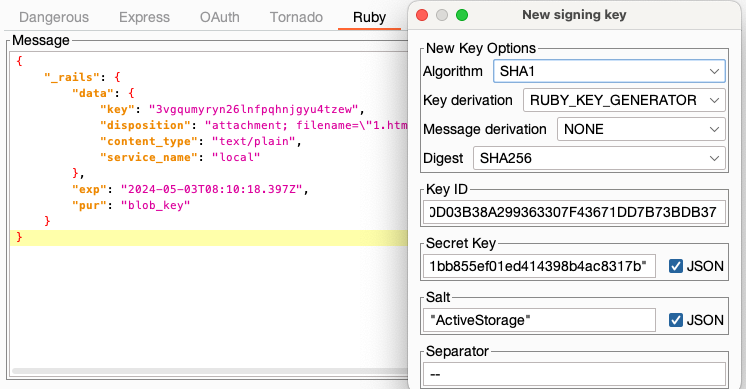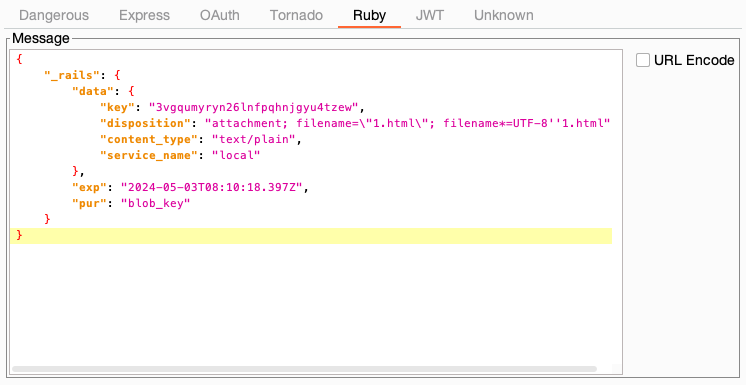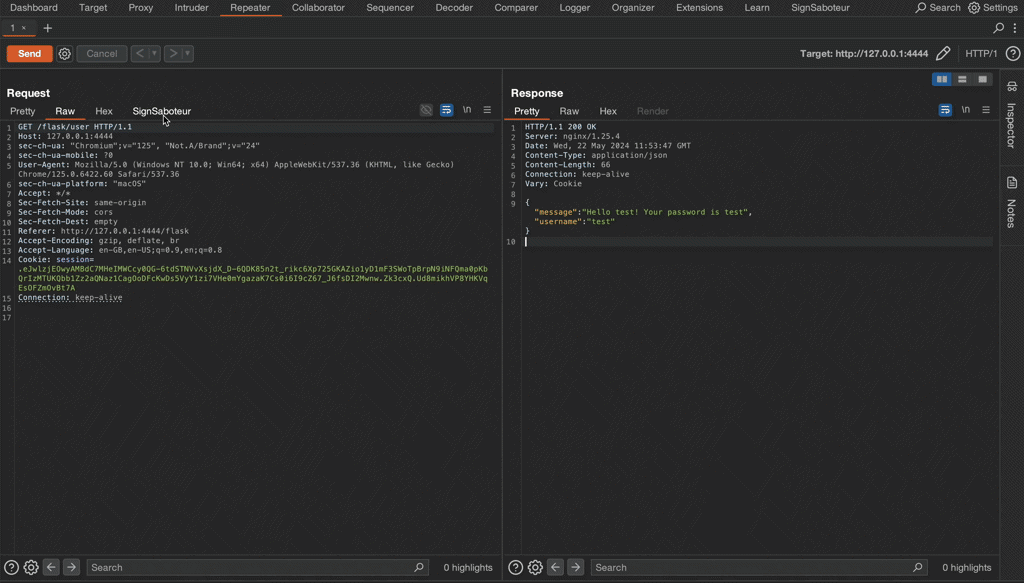
Published: 22 May 2024 at 12:37 UTC
Updated: 04 June 2024 at 07:25 UTC
 Signed web tokens are widely used for stateless authentication and authorization
throughout the web. The most popular format is JSON Web Tokens (JWT) which we've already covered in depth, but beyond that a diverse ecosystem of
standards thrives, each with its own implementation of data storage and security.
Signed web tokens are widely used for stateless authentication and authorization
throughout the web. The most popular format is JSON Web Tokens (JWT) which we've already covered in depth, but beyond that a diverse ecosystem of
standards thrives, each with its own implementation of data storage and security.
To help assess these, we've released a new open source extension for Burp Suite called SignSaboteur. This tool is designed to automate the attacks discussed here, ensuring that you no longer overlook any insecure configurations.
SignSaboteur is a Burp Suite extension for editing, signing, verifying, and attacking signed tokens. It supports different types of tokens, including Django, Flask, and Express.
The extension provides automatic detection and in-line editing of tokens within HTTP request / response pairs and WebSocket messages, signing of tokens and automation of brute force attacks.
SignSaboteur includes its own prebuilt word lists for known default secret keys and salts. You can extend them with your dictionary. JSON encoded strings are supported too, so you can include even non ASCII secrets keys. You can also save known keys for future brute force attacks.
You can modify the signed tokens in the Proxy and Repeater message editors. There are a number of built-in handy editors for JSON, timestamps and HEX strings.
But the true power of the tool is the unknown signed strings mode - more on that later.
To exploit a signed token, you usually need to discover the secret key. These may be disclosed in source code, configuration files, documentation pages, and error messages.
These papers provide a good overview of the different attacks:
To detect and exploit signed web tokens, we recommend the following methodology:
Brute force attacks are configured for each type of signed token. SignSaboteur enables you to use different strategies to find the secret key and salt:
As soon as you've identified the secret key, you can use the extension to run a number of authorization bypass attacks. All of these attacks can be used together:
First you need to install SignSaboteur in Burp Suite. Do this from the BApp Store under the Extensions tab. Of course you can also build the extension from source code.
To use the extension, open any HTTP request / response pair with a signed web token, then go to the SignSaboteur tab. Messages that include signed web tokens are automatically highlighted in the Proxy > HTTP history tab.
In the SignSaboteur tab, you can view all signed web tokens that are identified by the extension. These appear in the Token dropdown. Each web signed token’s type supports the fast brute force attack mode. That mode uses known message and derivation methods only.
If the extension finds a secret key and salt, you'll see a new secret key dialog. You can use known keys for future attacks. To do so, click Brute Force > Known keys or click Attack and select the key from the Signing keys dropdown.
To change keys, go to the SignSaboteur > Wordlist tab.
You can configure the search strategy to suit your preferences in the SignSaboteur > Settings tab. A list of all supported tokens is available for your reference. Please note that some tokens are disabled by default to help reduce noise.
When you select Unknown in the Enabled signers menu, the extension looks for patterns that match the size of common hashing functions. Some message payloads might be incorrectly identified by the SignSaboteur. You can manually change message and separator values to solve the issue. The extension supports different message and key derivation techniques with Brute Force attacks, so you don’t have to manually change them.
To find the secret key of an unknown signed token, go to the Unknown tab, click Brute force and choose from Balanced or Deep mode.
A word of caution, the deep brute force mode supports slow hashing functions like Password-Based Key Derivation Function 2. Use it with small wordlists only, otherwise the task will take too long.


This short GIF demonstrates how to find the unknown secret key of a Flask test application, modify the session token, and re-sign it.

You can try the extension in action on a self hosted lab available at Github repository. Good luck and have fun!